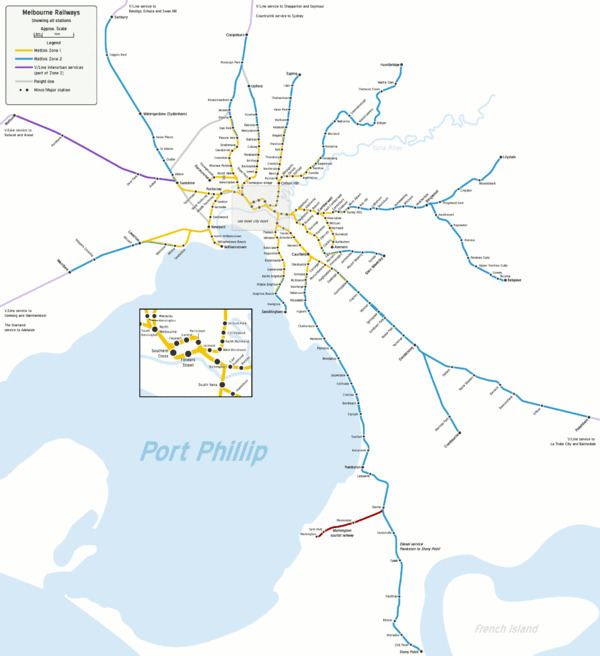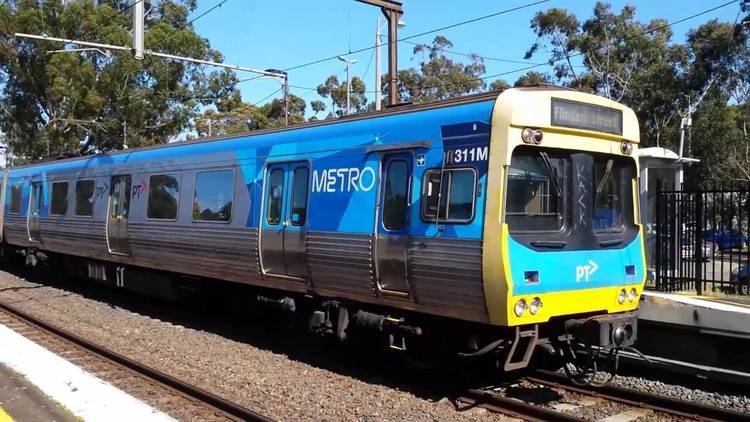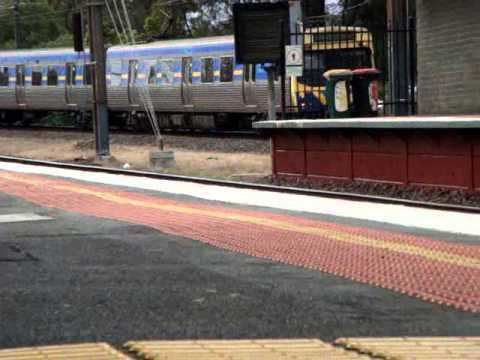Stations 10 | ||
 | ||
Type Melbourne suburban service Completed 1889 to Upper Ferntree Gully; 1900 2 ft 6 in (762 mm) narrow gauge through Belgrave to Gembrook; 1962 5 ft 3 in (1,600 mm) broad gauge to Belgrave | ||
The Belgrave railway line is a 5 ft 3 in (1,600 mm) broad gauge electric suburban railway in Melbourne, Australia. It branches from the Lilydale line at Ringwood station. It has eight stations, all of which are in myki ticketing Zone 2.
Contents

Description

The Belgrave line heads south-east from Ringwood, cutting across the Dandenong Creek valley and skirting the foothills of the Dandenong Ranges to Upper Ferntree Gully. This section has deep cuttings at Heathmont, Bayswater and Boronia where the line has been lowered to pass under adjacent intersections. The line now has few level crossings, on minor roads between Ferntree Gully and Upper Gully.

From Upper Ferntree Gully the line heads east taking the route of the former narrow gauge railway to Belgrave, climbing steeply into the southern part of the Dandenong Ranges. Earthworks are more extensive here, and all roads are crossed by means of bridges. Beyond Belgrave, the narrow gauge line has been restored to working order and runs to the original terminus of Gembrook as the Puffing Billy Railway.
Infrastructure

The line is double track to Ferntree Gully, then single track to Belgrave, with passing loops and island platforms at Upper Ferntree Gully, Upwey, and Belgrave. The line is controlled by automatic block signalling.

Intermediate terminating facilities are provided at Bayswater and Upper Ferntree Gully. Bayswater is not normally used for terminating, but is also the location of a repair centre. Stabling facilities are provided at Bayswater, Upper Ferntree Gully, and Belgrave.

For most of its length, it is paralleled by the Ringwood–Belgrave Rail Trail, a shared pedestrian and bicycling route.
History
The line from Ringwood to Upper Ferntree Gully was opened in December 1889. A narrow-gauge 2 ft 6 in (762 mm) line was opened from there to Gembrook in December 1900, the second of four experimental narrow-gauge lines built by the Victorian Railways.
In 1921, the narrow-gauge section from Upper Ferntree Gully to Belgrave was converted to automatic signalling, the first such instance on single track in the Southern Hemisphere. This section reverted to Staff and Ticket safeworking in 1930.
Electrification of the railway to Upper Ferntree Gully was implemented in November 1925.
Following a landslide in 1953, the narrow-gauge line was formally closed in April 1954, although it was reopened as far as Belgrave for some "farewell specials" and then for the Puffing Billy Preservation Society until again closed in February 1958.
The line was partly duplicated between Bayswater and Lower Ferntree Gully (now Ferntree Gully) in February 1957.
The narrow gauge line to Belgrave had been closed so that the line could be rebuilt as part of the suburban electrified system. The new, broad-gauge, electrified extension opened in February 1962. It initially operated on the Staff and Ticket system, but was converted to automatic signalling in March 1964, with the section from Ferntree Gully to Upper Ferntree Gully being converted the following day.
Ringwood to Bayswater was converted to automatic signalling in June 1974, as was Bayswater to Ferntree Gully in July 1977. In December 1982, Ringwood to Bayswater was duplicated.
The Comeng trains were introduced to the Melbourne railway system in 1981. Initially, along with the Belgrave line, they were only allowed to operate on the Alamein, Dandenong, Glen Waverley and Lilydale lines, due to the width of the trains (10 feet).
Services
Weekday off peak services stop all stations except East Richmond. Shoulder-peak and peak hour services often run express between Richmond and Box Hill, with most making stops at Glenferrie and Camberwell stations, and some stopping at Surrey Hills station. A small number of peak hour services also run express beyond Box Hill, stopping at Box Hill, Blackburn, Mitcham and Ringwood. A limited amount of peak services terminate at Upper Ferntree Gully.
Peak hour express trains are supplemented by Alamein line services stopping all stations between Flinders Street and Camberwell, as well as all stations short runs to Blackburn, with a select number of these services skipping East Richmond or Laburnum.
Weekend services on the Belgrave line run direct from Richmond to Flinders Street and then commence outbound journeys via the City Loop, stopping all stations to Belgrave except East Richmond. Early morning weekend services run direct to and from Flinders Street, stopping all stations including East Richmond.
Belgrave and Lilydale line trains alternate as shuttles from and to Ringwood during early morning and late night services all week.
In 2016, the Belgrave line has been announced that these railway crossings began to remove at Bayswater Station.
Line guide
Bold stations are termini, where some train services terminate; italic stations are staffed.
Branches from the Lilydale line at Ringwood.
